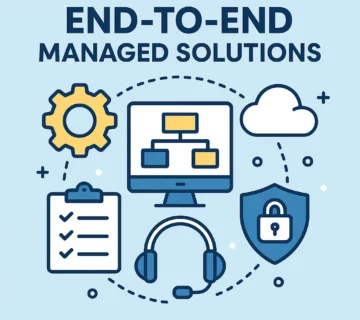Introduction to Desktop Support: Your Complete Guide to IT’s Front Line

In today’s technology-driven workplace, desktop support professionals serve as the crucial bridge between complex computer systems and the people who rely on them daily. Whether you’re considering a career in IT or simply want to understand what desktop support entails, this comprehensive guide will walk you through everything you need to know about this essential field.
What is Desktop Support?
Desktop support, also known as technical support or help desk support, involves providing technical assistance to end users experiencing computer-related problems. These professionals troubleshoot hardware and software issues, maintain computer systems, and ensure that employees can work efficiently with their technology tools.
Unlike specialized IT roles that focus on servers, networks, or cybersecurity, desktop support technicians work directly with individual users and their personal computing devices. This makes them the most visible face of the IT department in many organizations.
Core Responsibilities of Desktop Support Professionals
Desktop support technicians wear many hats throughout their workday. Their primary responsibilities include diagnosing and resolving hardware malfunctions, from replacing faulty RAM modules to troubleshooting printer connectivity issues. They also handle software-related problems, such as application crashes, operating system errors, and compatibility conflicts between different programs.
In addition to resolving issues as they arise, desktop support professionals also carry out proactive maintenance to prevent future problems. They install software updates, configure new user accounts, set up workstations for new employees, and ensure that security patches are properly applied across all systems. Many also participate in larger IT projects, such as company-wide software deployments or hardware refresh initiatives.
Documentation plays a crucial role in their daily work. Support technicians must record details of each issue they encounter, the steps taken to resolve it, and any follow-up actions required. This documentation helps build a knowledge base that benefits the entire team and improves response times for similar future issues.
Essential Technical Skills
Success in desktop support requires a broad foundation of technical knowledge. Proficiency with major operating systems including Windows, macOS, and various Linux distributions is fundamental. Support technicians must understand how these systems work, common failure points, and effective troubleshooting methodologies.
Hardware knowledge spans everything from basic computer components to peripheral devices. Understanding how processors, memory, storage devices, and graphics cards function helps technicians quickly identify hardware-related problems. Familiarity with mobile devices, tablets, and their integration with corporate systems has become increasingly important as workplaces embrace mobility.
Networking fundamentals are equally critical. Desktop support professionals need to understand TCP/IP, DNS, DHCP, and wireless networking concepts to troubleshoot connectivity issues effectively. They should also be comfortable with remote access tools, as many support scenarios require connecting to user systems from a distance.
Software expertise extends beyond operating systems to include productivity applications, web browsers, email clients, and industry-specific programs. Many organizations rely on particular software suites, so technicians often develop specialized knowledge in these areas.
The Human Side of Technical Support
While technical skills form the foundation of desktop support, interpersonal abilities often determine career success. Support technicians regularly interact with frustrated users who may lack technical knowledge and feel overwhelmed by computer problems. The ability to remain patient, communicate clearly in non-technical terms, and maintain a helpful attitude under pressure is invaluable.
Active listening skills help technicians understand the real problem behind a user’s description, which may not always be technically accurate. Teaching abilities come into play when showing users how to prevent similar issues in the future or use new software features effectively.
Time management and prioritization skills are essential when juggling multiple support requests. Technicians must assess the urgency and business impact of different issues to allocate their time effectively. A server outage affecting dozens of users requires immediate attention, while a single user’s cosmetic software preference can wait.
Career Paths and Advancement Opportunities
Desktop support often serves as an entry point into the broader IT field, offering numerous pathways for career growth. Many professionals use desktop support experience as a stepping stone to specialized roles in network administration, cybersecurity, or systems engineering.
Within support organizations, career progression typically follows a tiered structure. Level 1 technicians handle basic issues and escalate complex problems to Level 2 or Level 3 specialists. With experience, support professionals can advance to senior technician roles, team leadership positions, or IT management roles.
Some desktop support professionals choose to specialize in particular areas such as mobile device management, virtualization technologies, or specific software platforms. Others transition to consulting roles, helping multiple organizations improve their IT support processes.
The skills developed in desktop support translate well to many other IT disciplines. The broad exposure to different technologies and business processes provides excellent preparation for roles in IT project management, business analysis, or vendor management.
Industry Trends Shaping Desktop Support
The desktop support field continues to evolve alongside technological advances and changing workplace dynamics. Cloud computing has shifted many traditional desktop applications to web-based platforms, requiring support technicians to understand browser-based troubleshooting and connectivity issues.
Remote work trends have fundamentally changed how desktop support operates. Technicians now rely heavily on remote access tools and must be skilled at guiding users through troubleshooting steps over phone or video calls. This shift has increased the importance of clear communication skills and creative problem-solving abilities.
Artificial intelligence and automation are beginning to impact desktop support through chatbots that can handle routine requests and automated diagnostic tools that can identify common problems. Rather than replacing support technicians, these tools are freeing them to focus on more complex issues that require human expertise and judgment.
The bring-your-own-device trend in many workplaces has expanded the scope of desktop support to include personal smartphones, tablets, and laptops. This requires broader technical knowledge and familiarity with mobile device management platforms.
Getting Started in Desktop Support
For those interested in pursuing desktop support careers, several pathways can provide the necessary foundation. Formal education options include associate degrees in information technology or computer science, though many employers also consider candidates with relevant certifications and practical experience.
Industry certifications such as CompTIA A+, Microsoft certified professional credentials, and vendor-specific certifications can demonstrate technical competency to potential employers. Many of these certifications can be earned through self-study combined with hands-on practice.
Building a home laboratory environment provides valuable practical experience. Setting up multiple operating systems, configuring networks, and deliberately breaking things to practice troubleshooting helps develop the skills needed for professional desktop support roles.
Volunteer opportunities with nonprofit organizations or small businesses can provide real-world experience while building professional networks. Many desktop support professionals began their careers by helping friends, family, or community organizations with their computer problems.
Desktop support offers a rewarding career path for individuals who enjoy solving technical problems and helping others. The field provides excellent exposure to various technologies while developing valuable interpersonal and professional skills. As organizations continue to rely heavily on technology, skilled desktop support professionals remain essential to maintaining productive and efficient workplaces.
Whether you’re just starting your IT journey or looking to understand the critical role desktop support plays in modern organizations, this field offers both immediate career opportunities and a solid foundation for long-term professional growth in technology.







